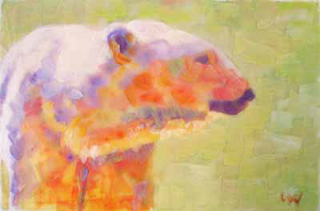Having always admired the effects artists painting in the encaustic mode can get, but not wanting to deal with melted wax, I've turned to trying acrylic paints to create a encaustic effect (called faux encaustic).
First, though, what is encaustic painting and what are some good examples of it? According to Wikipedia --
***
***
The Encaustic Painting Group features this piece, which is a good example of what draws me to encaustics, by Kari J. Young.
***
***
To see how faux encaustic effects are achieved using acrylics, take a look at this video by Golden Paints.
***
***
Lisa Walsh's "Acrylic Encaustic Bear" is a good example and a sweet piece. However, I don't see the textures that are present in the not-faux encaustic.
***
***
Guess it's time for me to get to work and see what I can do.
--Marge
First, though, what is encaustic painting and what are some good examples of it? According to Wikipedia --
Encaustic painting, also known as hot wax painting, involves using heated beeswax to which colored pigments are added. The liquid or paste is then applied to a surface—usually prepared wood, though canvas and other materials are often used.A noted artist using this method is Tony Scherman. Here he talks about the method and his technique.
***
The Encaustic Painting Group features this piece, which is a good example of what draws me to encaustics, by Kari J. Young.
***
 |
| Kari J. Young, "Metamorphosis," Encaustic Painting Group |
To see how faux encaustic effects are achieved using acrylics, take a look at this video by Golden Paints.
***
Lisa Walsh's "Acrylic Encaustic Bear" is a good example and a sweet piece. However, I don't see the textures that are present in the not-faux encaustic.
***
 |
| Lisa Walsh, "Acrylic Encaustic Bear" |
Guess it's time for me to get to work and see what I can do.
--Marge

No comments:
Post a Comment